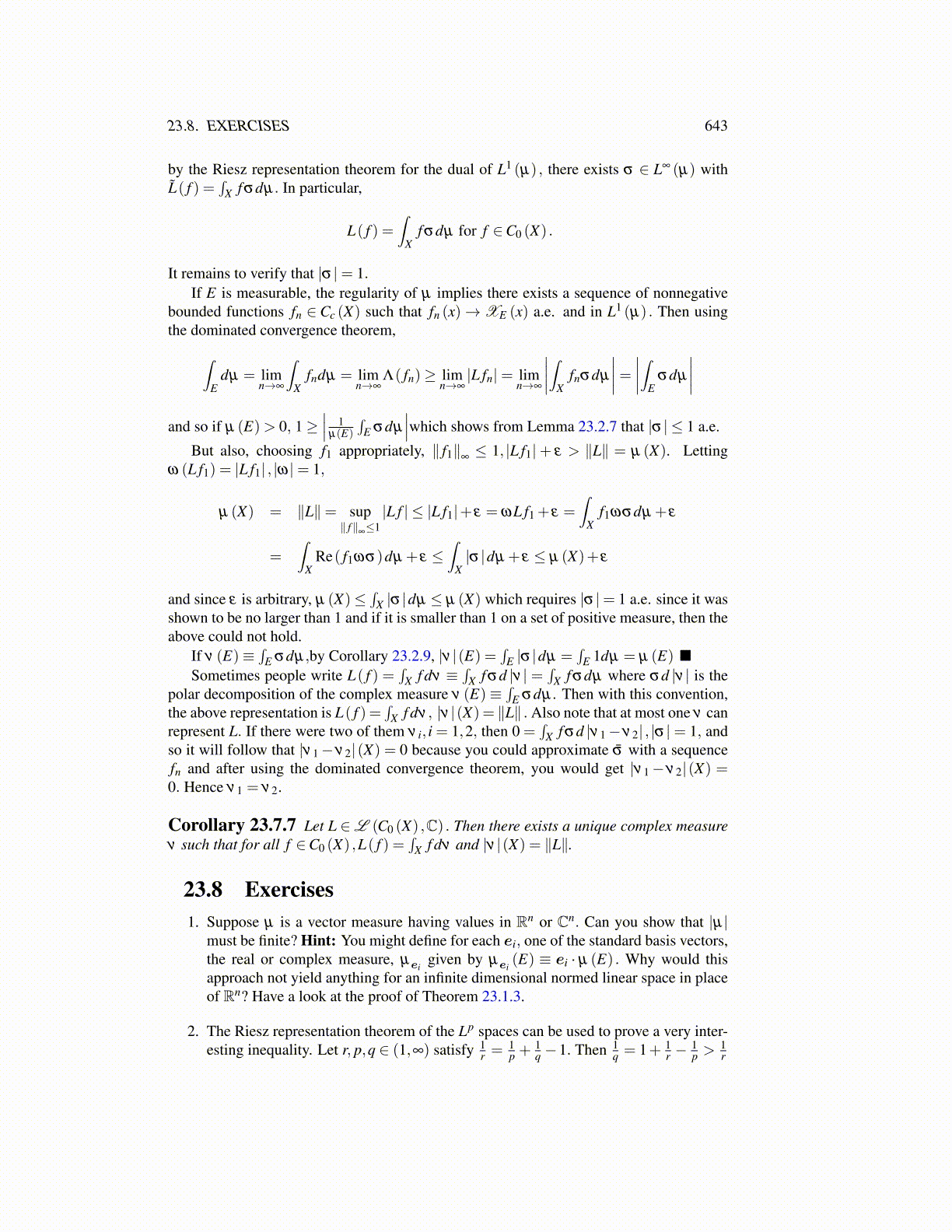
23.8. EXERCISES 643
by the Riesz representation theorem for the dual of L1 (µ) , there exists σ ∈ L∞ (µ) withL̃( f ) =
∫X f σdµ. In particular,
L( f ) =∫
Xf σdµ for f ∈C0 (X) .
It remains to verify that |σ |= 1.If E is measurable, the regularity of µ implies there exists a sequence of nonnegative
bounded functions fn ∈ Cc (X) such that fn (x)→XE (x) a.e. and in L1 (µ) . Then usingthe dominated convergence theorem,∫
Edµ = lim
n→∞
∫X
fndµ = limn→∞
Λ( fn)≥ limn→∞|L fn|= lim
n→∞
∣∣∣∣∫Xfnσdµ
∣∣∣∣= ∣∣∣∣∫Eσdµ
∣∣∣∣and so if µ (E)> 0, 1≥
∣∣∣ 1µ(E)
∫E σdµ
∣∣∣which shows from Lemma 23.2.7 that |σ | ≤ 1 a.e.
But also, choosing f1 appropriately, ∥ f1∥∞≤ 1, |L f1|+ ε > ∥L∥ = µ (X). Letting
ω (L f1) = |L f1| , |ω|= 1,
µ (X) = ∥L∥= sup∥ f∥∞≤1
|L f | ≤ |L f1|+ ε = ωL f1 + ε =∫
Xf1ωσdµ + ε
=∫
XRe( f1ωσ)dµ + ε ≤
∫X|σ |dµ + ε ≤ µ (X)+ ε
and since ε is arbitrary, µ (X)≤∫
X |σ |dµ ≤ µ (X) which requires |σ |= 1 a.e. since it wasshown to be no larger than 1 and if it is smaller than 1 on a set of positive measure, then theabove could not hold.
If ν (E)≡∫
E σdµ,by Corollary 23.2.9, |ν |(E) =∫
E |σ |dµ =∫
E 1dµ = µ (E) ■Sometimes people write L( f ) =
∫X f dν ≡
∫X f σd |ν | =
∫X f σdµ where σd |ν | is the
polar decomposition of the complex measure ν (E)≡∫
E σdµ . Then with this convention,the above representation is L( f ) =
∫X f dν , |ν |(X) = ∥L∥ . Also note that at most one ν can
represent L. If there were two of them ν i, i = 1,2, then 0 =∫
X f σd |ν1−ν2| , |σ |= 1, andso it will follow that |ν1−ν2|(X) = 0 because you could approximate σ̄ with a sequencefn and after using the dominated convergence theorem, you would get |ν1−ν2|(X) =0. Hence ν1 = ν2.
Corollary 23.7.7 Let L ∈L (C0 (X) ,C) . Then there exists a unique complex measureν such that for all f ∈C0 (X) ,L( f ) =
∫X f dν and |ν |(X) = ∥L∥.
23.8 Exercises1. Suppose µ is a vector measure having values in Rn or Cn. Can you show that |µ|
must be finite? Hint: You might define for each ei, one of the standard basis vectors,the real or complex measure, µei
given by µei(E) ≡ ei · µ (E) . Why would this
approach not yield anything for an infinite dimensional normed linear space in placeof Rn? Have a look at the proof of Theorem 23.1.3.
2. The Riesz representation theorem of the Lp spaces can be used to prove a very inter-esting inequality. Let r, p,q ∈ (1,∞) satisfy 1
r = 1p +
1q −1. Then 1
q = 1+ 1r −
1p > 1
r